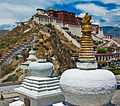Potala Palace
The Potala Palace (T. pho brang po ta la ཕོ་བྲང་པོ་ཏ་ལ་) in Lhasa, Tibet, was the winter palace of the Dalai Lamas from 1649 to 1959. It has been a World Heritage Site since 1994.
The palace is named after Mount Potalaka, the mythical abode of the bodhisattva Avalokiteśvara.[1] The 5th Dalai Lama started its construction in 1645[2] after one of his spiritual advisers, Konchog Chophel (died 1646), pointed out that the site was ideal as a seat of government, situated as it is between Drepung and Sera monasteries and the old city of Lhasa.[3] It may overlay the remains of an earlier fortress called the White or Red Palace on the site,[4] built by Songtsen Gampo in 637.[5]
Tradition has it that the three main hills of Lhasa represent the "Three Protectors of Tibet". Chokpori, just to the south of the Potala, is the soul-mountain (Wylie: bla ri) of Vajrapani, Pongwari that of Manjusri, and Marpori, the hill on which the Potala stands, represents Avalokiteśvara.[6]
Gallery
See also
- Norbulingka, the Dalai Lama's former summer palace
Notes
- ↑ Stein, R. A. Tibetan Civilization (1962). Translated into English with minor revisions by the author. 1st English edition by Faber & Faber, London (1972). Reprint: Stanford University Press (1972), p. 84
- ↑ Laird, Thomas. (2006). The Story of Tibet: Conversations with the Dalai Lama, pp. 175. Grove Press, New York. ISBN 978-0-8021-1827-1.
- ↑ Karmay, Samten C. (2005). "The Great Fifth", p. 1. Downloaded as a pdf file on 16 December 2007 from: [1] Archived 15 September 2013 at the Wayback Machine.
- ↑ W. D. Shakabpa, One hundred thousand moons, translated with an introduction by Derek F. Maher, Vol.1, BRILL, 2010 p. 48
- ↑ Michael Dillon, China : a cultural and historical dictionary, Routledge, 1998, p. 184.
- ↑ Stein, R. A. (1972). Tibetan Civilization, p. 228. Translated by J. E. Stapleton Driver. Stanford University Press, Stanford, California.
External links
 Potala Palace, Wikipedia
Potala Palace, Wikipedia- Potala Palace, UNESCO World Heritage Convention
| This article includes content from Potala Palace on Wikipedia (view authors). License under CC BY-SA 3.0. |









